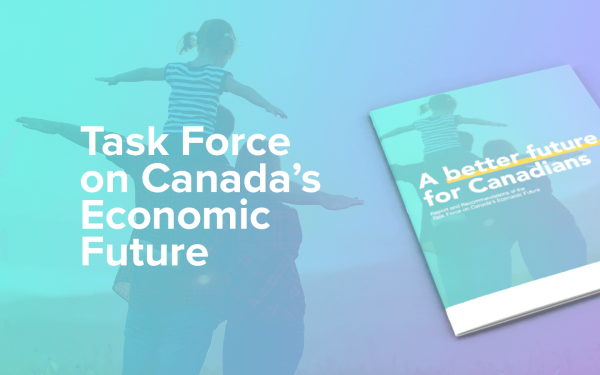A better future for Canadians
Report and recommendations of the Task Force on Canada's Economic Future
A message for Canada's political leaders
Little more than a week ago, Canadian voters cast their ballots after one of the most polarized, fractious and dispiriting federal election campaigns in memory.
Parliament is divided, no party having earned the right to pass legislation without the support of at least some of its rivals. But a divided Parliament need not be a dysfunctional Parliament.
It is time for Canada’s elected representatives to put aside partisan acrimony and elevate the country’s interests above their own. It is time for MPs to come together in pursuit of a positive, forward-thinking agenda that will improve the lives of Canadians today and in the future.
The country is at a crossroads. Numerous independent studies have concluded that Canadians’ standard of living and quality of life are at risk. An aging population, lagging productivity, rapid technological change and a fragmenting global order pose serious threats to Canada’s economy.
On the campaign trail and in the platforms of your parties, these issues received little or no attention. They cannot and must not be ignored any longer.
Over the past nine months, we have asked a broad cross-section of Canadians to share their ideas to improve the country’s economic future. This report represents the outcome of those consultations. It puts forward six practical, realistic recommendations to expand Canada’s economic potential, spur investment and job creation, and ensure a better future for all citizens. Each of these recommendations, we are convinced, is deserving
of broad, multi-party support.
As employers, we share in the responsibility to promote greater opportunity for all Canadians. That is why we are also putting forward six
concrete, meaningful actions that we in the business community will take to help make the most of the country’s human potential.
As leaders, you now have a choice. Between now and the next campaign, you can devote your energies to the struggle for short-term tactical advantage. Or you can recognize that the world is changing—and changing fast. Canadians need and deserve a positive vision of Canada's future and a coherent agenda to make that vision a reality.
We urge you to seize this opportunity to build a brighter future for Canada.
Introduction
Canada’s population is aging, and our economy is underperforming. Combined, these two trends seriously threaten Canadians’ standard of living and quality of life.
Slower economic growth over the long run will inevitably mean fewer opportunities for our children and grandchildren, higher rates of unemployment, and less money for cherished public services such
as health care, education and transit.
That may sound alarmist, but numerous independent experts and blue-ribbon panels have reached similar conclusions. All agree that our country faces serious economic headwinds. All agree that the well-being of our citizens will suffer if we fail to recognize these threats and take action soon to address them.
As business leaders, employers and proud Canadians, we are committed to working with others to build a stronger, more successful country. Earlier this year, we launched a new initiative aimed at advancing urgently needed policies to enhance growth and prosperity, ensuring a better future for all citizens.
Led by three of our member chief executives—Chuck Magro of Nutrien Ltd., Nicole Verkindt of OMX and Louis O. Vachon of National Bank of Canada—the Task Force on Canada’s Economic Future has consulted widely, welcoming input from Canadians in every region and from every walk of life.
We convened expert roundtables in Montreal, Toronto and Calgary. We heard from social service agencies, environmental groups, indigenous organizations, urban policy specialists, economists and current and former elected officials from all three levels of government.
We solicited input from dozens of industry associations and non-profit organizations, ranging from the Canadian Labour Congress to the Federation of Canadian Municipalities.
And we received more than 100 submissions from individual Canadians in communities across the country—men and women united by a desire to see their country achieve its full potential.
Based on the advice we received as well as our own experiences as business leaders and entrepreneurs, we set out to develop a short list of specific, practical recommendations to increase Canada’s economic potential. On the following pages we outline our recommendations and the reasons why we believe they deserve to be implemented.
We hasten to add that none of these ideas is entirely new. Just over a decade ago, the federal Competition Policy Review Panel, chaired by Lynton R. “Red” Wilson, proposed a comprehensive set of policy reforms aimed at making Canada a more attractive destination for talent, investment and innovation. More recently, the Advisory Council on Economic Growth, led by Dominic Barton, conducted a broad assessment of Canada’s economic challenges organized around the core foundations of our national economy: skills and workforce participation, innovation, infrastructure and capital investment, and the competitive market environment. The Advisory Council’s work in turn spurred the creation of six Economic Strategy Tables focused on key industries: advanced manufacturing, agri-food, clean technology, digital industries, health/bio-sciences and resources of the future.
Each of these exercises produced sound recommendations and detailed reports outlining the challenges facing Canada’s economy. Some of those recommendations have been implemented, but the vast majority have not.
There are undoubtedly many reasons for this, but we believe the single biggest impediment to action is complacency.
In saying this, we are not attempting to point fingers. After all, Canada’s private sector is as prone to complacency as anyone else. On average, Canadian companies spend less on research and development than their peers in many other advanced countries. They spend less per employee on learning and development, and they are slower to adopt new technology than their counterparts in Europe and the United States.
It is natural, perhaps inevitable, that after many years of economic success, Canadians would assume that economic growth and high living standards are our birthright. Even when, in 2008–09, most of the world’s developed economies suffered the most severe economic and financial meltdown since the 1930s, Canada experienced only a comparatively mild downturn. Since then, extremely low interest rates have fed another kind of complacency, encouraging consumers and governments to
go deeper into debt.
In effect, we have been resting on our laurels. We tell ourselves that our economy is resilient to shocks and uncertainty, ignoring the uncomfortable truth that our future is not guaranteed and that the world around us is changing rapidly.
Canada's aging population will mean slower economic growth and higher spending on seniors
The internal and external risks to Canada’s economy are many. We have already mentioned our country’s aging population. In 2012, one in seven Canadians was a senior. By 2030, that number will climb to one in four. A smaller share of the population will be working and paying taxes. The projected results include lower economic growth, slower growth in government revenue and higher spending on income transfer programs for seniors.
A shrinking workforce would not matter so much if Canada’s productivity was higher than that of peer countries, but in fact the reverse is true. In 2018, the average Canadian generated $50 (U.S.) in output per hour of labour, compared to $60 (U.S.) per hour in Switzerland and $65 (U.S.) per hour in the United States. Over the long run, the level of productivity is the single most important determinant of a country’s standard of living. Canada’s productivity rates have lagged for decades, resulting in lower incomes and lower household purchasing power.
Beyond these domestic risks, Canada faces the unfolding challenge of the digital revolution, a fragmenting global order, an historic shift of economic gravity to Asia, growing isolationism in the United States and parts of Europe, and rising international protectionism.
Along with the rest of the world, we must also prepare for the multi-faceted challenge of global climate change, including the likelihood of more frequent extreme weather events and the need for significant financial investments to support the transition to a low-carbon society.
***
We launched our Task Force earlier this year because we are convinced that Canada’s economy is at a crossroads. That said, we are optimistic about the country’s future. Canada is blessed with abundant natural and human resources, strong institutions, entrepreneurial spirit and a long history of overcoming major challenges. There is no doubt in our minds that Canada can succeed again. We simply need to acknowledge the scope of our economic challenges and take action to address them.
How would success—faster economic growth— benefit individual Canadian workers and families? In its first report, the Advisory Council on Economic Growth set a goal of boosting yearly pre-tax income for the median Canadian household to $105,000 by 2030—$15,000 more than the level otherwise expected that year. To accomplish that would require an approximate doubling of the annual rate of economic growth over the next decade.
We view the Growth Council’s target as both realistic and achievable—but there is no time to waste. We must act now to strengthen Canada’s economic base and remove obstacles to growth. We must work together constructively to spur investment, support the creation of high-value jobs, and better enable Canadians of all backgrounds to achieve their potential.
We are conscious of the maxim that someone who has too many priorities in reality has none. For that reason, we have limited ourselves to six main recommendations for government. We believe that all six are important in unleashing Canada’s growth potential, but in the near term we would prefer to see real results in one or two areas rather than slow or insignificant progress in five or six.
In our view, regulatory modernization has the greatest potential to improve the lives of citizens, drive innovation and enhance business activity across the board. Again and again during our consultations, participants cited inefficient regulation as the single greatest obstacle to Canadian competitiveness and economic growth. Every government pays lip service to red-tape reduction, and now and then there are moves in the right direction. Yet the regulatory environment continues to increase in both complexity and unpredictability, creating unnecessary barriers to innovation and growth. It is time for a new approach.
In saying this, and in presenting our other recommendations for government, we do not mean to suggest that strengthening Canada’s economic capacity is entirely the responsibility of the public sector. Far from it.
As employers, we know we have a special responsibility to help make the most of Canada’s human potential. We see opportunities in several areas: closing gaps in labour force participation among disadvantaged groups; fully embracing diversity and inclusion in the workplace; promoting mental health; investing in employee learning and development; expanding career opportunities for young Canadians; and supporting the next generation of Canadian innovators and entrepreneurs.
This report puts forward recommendations in each of the above areas. We encourage all companies to join us in building a more inclusive, skilled and agile Canadian workforce.
Recommendations for Government
Modernize the regulatory environment
Canada should commit to the goal of being the most efficiently regulated country on earth, as measured by the World Bank’s “Doing Business” index and the World Economic Forum’s annual Competitiveness rankings.
A survey of Business Council members in January 2019 identified the regulatory burden as the single most important factor weighing on Canadian competitiveness. This sentiment is borne out by numerous independent comparisons of regulatory governance. For example, since 2006 Canada has fallen from fourth place to 22nd in an annual World Bank study that measures the regulatory burden on business. In the 2018 World Economic Forum (WEF) Global Competitiveness Index, Canada ranked 12th out of 140 countries in overall competitiveness, but 53rd based on the burden of government regulations. Many of these regulatory barriers stem from duplication and inadequate alignment across federal, provincial, territorial and municipal governments. A 2019 study by the International Monetary Fund concluded that reducing internal trade barriers in Canada could boost per capita GDP by four per cent.
These dismal findings are of more than theoretical interest. They directly influence international perceptions of Canada as a place to do business and, in so doing, undermine our country’s ongoing efforts to attract foreign direct investment. They raise costs for consumers, reduce employment opportunities and limit the ability of businesses to invest in new, productivity-enhancing machinery and processes.
In early 2019, acting on recommendations from the Canadian Chamber of Commerce, the Advisory Council on Economic Growth, and the Economic Strategy Tables, the federal government established the External Advisory Committee on Regulatory Competitiveness. The committee brings together business, academic and consumer representatives from across the country to provide an independent perspective on barriers to business success. We see this as a positive step, but it falls short in one critical respect: its role is limited to providing advice to Treasury Board.
In our view, what is needed is an independent, arm’s-length oversight agency with the ability to issue public reports and a legislated mandate that transcends the political cycle. The agency’s mission would be to shine a light on the cumulative impact of regulation on Canada’s national economy, helping governments at all levels prioritize their efforts to reform and modernize the system. In recent years both Germany and Denmark have created similar watchdog institutions, improving the transparency and accountability of the regulatory system while reducing the regulatory burden on businesses and citizens.
Both Germany and Denmark have created watchdog agencies to tackle unnecessary bureaucracy
Germany’s Regulatory Control Council (Normenkontrollrat, or NKR) was established in 2006 as an autonomous advisory body that works to prevent unnecessary bureaucracy and reduce compliance costs. Before the German federal government adopts any new piece of legislation, the NKR reviews the ministries’ estimates of compliance costs for citizens, businesses and public authorities and reports to both parliament and the German public. The NKR also reviews existing administrative procedures in order to make them simpler and faster. Recent examples include the application processes for parental benefits, work and residence permits for skilled foreign labour, and the reduction of bureaucracy in the everyday life of physicians and dentists.
Denmark’s approach to regulatory simplification is similarly based on the principle of independent oversight. In 2012, the Danish government established the Business Forum for Better Regulation, composed of representatives of industry and labour organizations, businesses, and professionals with expertise in simplification. The forum meets three times a year to identify and propose reforms, which can include changing rules, introducing new processes or shortening processing times.
Importantly, the forum’s recommendations are covered by a “comply or explain” rule, meaning the government must either accept the forum’s proposals or explain why it has chosen not to do so. As of October 2019, the forum had submitted 803 proposals for regulatory streamlining, of which 294 had been fully and 305 partially implemented. Another 74 ideas are under active consideration. To improve transparency and accountability, progress is reported in real-time and in plain language on a website, to which members of the public are invited to submit suggestions for further reform.
What others are saying
“Standards are important, but regulations should not necessarily dictate how those standards are to be met. Too often we take a ‘belt and suspenders’ approach. The result is unnecessary costs and delays, and too many sub-scale firms.”
Roundtable participant in Toronto
“We urgently need to establish a modern regulatory system that fosters innovation and adoption by focusing on outcomes, not prescriptions. This will require a new, collaborative relationship between industry and regulators, and has to move away from a system that requires multiple, overlapping reporting requirements for the same issue.”
Canada’s Economic Strategy Tables, September 25, 2018
“To stimulate more investment and attract more capital, Canada should aspire to set the global gold standard for regulatory efficiency and predictability.”
Advisory Council on Economic Growth, “Investing in a Resilient Canadian Economy”, December 1, 2017
“There are investors who would like to invest in Canadian oil and gas, but they are afraid of how complex Canada’s regulatory system has become.”
Roundtable participant in Calgary
“The Canadian Free Trade Agreement was a good first step, but so far it really hasn’t amounted to much. The provinces are pursuing internal trade liberalization in an ad hoc way, going line by line through different regulations and trying to harmonize them. [W]e can do better than that.”
Roundtable participant in Calgary
“It’s harder to do business in Canada than in many other jurisdictions, and it is difficult to launch major projects.”
Roundtable participant in Montreal
“In Canada we have a regulatory patchwork, which is slowing investment. We need better intergovernmental coordination.”
Roundtable participant in Montreal
“Norway is using the money it earns from oil to fund its transition to renewable energy. But it takes an average of 900 days to get approval [for an oil project] in Canada, as opposed to 120 days in Norway. Canada is very slow.”
Roundtable participant in Montreal
Prioritize nationally significant infrastructure projects
The federal government should establish an independent statutory body with a mandate to identify and prioritize nationally significant infrastructure projects.
A country’s productivity and prosperity are closely tied to the quality of its infrastructure. This is particularly true in Canada, given our country’s vast size and dependence on international trade. Outdated or insufficient infrastructure raises costs to consumers and discourages companies from locating in Canada or expanding existing operations. All Canadians have paid the price for inadequate pipeline infrastructure, which seriously constrains energy exports.
Canada lags its international peers in infrastructure spending. We invest less per capita than other countries in transportation, energy, waste, water, utilities and communications. According to the 2019 Canadian Infrastructure Report Card—produced by the Federation of Canadian Municipalities and seven partner organizations—nearly 40 per cent of municipal roads and bridges are in fair, poor or very poor condition. The World Bank, meanwhile, ranks Canada 23rd in the world based on the quality of trade and transportation infrastructure, such as ports, railroads and highways. Germany is in first place and the United States is in seventh.
In its first report, the Advisory Council on Economic Growth cited estimates of Canada’s “infrastructure gap” ranging from a low of $150 billion to as much as $1 trillion. The exact size is unknown—in part because there is no nationwide source of reliable data on the current state of the country’s infrastructure. In addition, existing estimates do not take into account the potential for, in the Growth Council’s words, “large scale nation-building projects for governments seeking to make step change improvements in growth and productivity”.
All Canadians have paid the price for inadequate pipeline infrastructure
In 2017, the federal government responded to the Growth Council’s report by establishing the Canada Infrastructure Bank. The bank’s mandate is to co-invest with the private sector and institutional investors in new, revenue-generating infrastructure projects that are in the public interest.
We support the Canada Infrastructure Bank and its potential to leverage new and creative kinds of investments in major infrastructure projects. But its establishment still leaves Canada without a reliable, nationwide source of data on the state of the country’s infrastructure, and no independent source of advice to governments, industry and the public on the investments and reforms needed to deliver better infrastructure for all Canadians.
To put it another way, there is no objective basis on which an average citizen could judge whether the infrastructure projects that receive public funding are, in fact, the ones that will deliver the greatest bang for the buck in terms of job creation, productivity and economic growth. Typically in Canada, governments announce a flurry of investments in infrastructure projects—or funding to study potential infrastructure projects—in the weeks leading up to an election campaign. Are those projects selected on the basis of need, economic significance or some other widely understood metric? Or are they chosen primarily because of their appeal to specific groups of voters in areas of the country where the party in power is looking to attract votes?
We believe Canada should adopt a more methodical, transparent and strategic process for prioritizing major infrastructure projects and arriving at funding decisions. Canadians need an approach that looks beyond elections and budgetary cycles to identify the projects that will best meet the country’s future needs. The easiest way to do that would be to borrow from Australia the model of an independent, non-partisan body to provide independent research and advice to all levels of government as well as to investors and owners of nationally significant infrastructure.
Infrastructure Australia was established in 2008. Initially it operated within the federal Department of Infrastructure and Regional Development, but in 2014 it was given new powers and an independent board with the right to appoint its own Chief Executive Officer. It conducts periodic audits of the country’s nationally significant infrastructure, develops 15-year rolling infrastructure plans to enhance productivity and economic growth, and weighs the business case for each project. It is insulated from the political process and can therefore assess infrastructure needs and develop recommendations on the basis of objective scientific and economic criteria.
Infrastructure Australia has no role in financing or developing infrastructure, and governments are free to ignore its advice. But its reports ensure greater transparency and accountability in decision-making—areas where Canada’s approach to infrastructure planning falls short.
What others are saying
“A rolling plan would provide a strategic approach to infrastructure planning, including prioritization of projects to address critical bottlenecks to meet our growth targets. The plan should be developed by a committee of industry and government reporting to federal, provincial and territorial ministers of transport and infrastructure.”
Report from Canada’s Economic Strategy Tables, September 25, 2018
“We have under-invested for decades. Even many countries that are less wealthy than Canada have better infrastructure than us.”
Roundtable participant in Montreal, June 18, 2019
“The core problem is that the infrastructure cycle— how long it takes to plan and build—is much longer than the political cycle. As a result, the quality of Canadian infrastructure, from our cities to our small towns, is far below what it needs to be.”
Roundtable participant in Toronto, June 4, 2019
“Business needs to talk about the importance of high-quality, modern infrastructure [such as urban transit] to liveability and the ability to attract talent… Without the infrastructure you won’t have liveability, and without liveability you won’t see business grow.”
Roundtable participant in Toronto, June 4, 2019
“Without an ongoing planning process and coherent funding strategy for infrastructure, Canada is falling behind other countries—this impacts business competitiveness, job growth and quality of life.”
Jan De Silva, President & CEO, Toronto Region Board of Trade
Modernize and simplify the tax system
The federal government should launch an independent review of Canada’s tax system aimed at strengthening the country’s ability to attract and retain business investment and talent.
A comprehensive review of Canada’s tax system is long overdue. The last thorough examination of the tax system took place more than 50 years ago. Since then, revisions and additions to the tax code have expanded the Income Tax Act to 3,281 pages, dramatically increasing its complexity and creating a wide range of inefficiencies.
Canada is experiencing rapid economic transformation, technological disruption, intense global competition and unprecedented mobility of both capital and talent. We should be asking ourselves whether the tax system built, revised and amended by successive generations of Canadians is still the right one to meet the challenges our country faces today and is likely to face in the future.
According to the World Bank, Canada ranks 19th globally for the ease of paying taxes, well behind countries such as Ireland, Denmark and New Zealand. On average, it takes a company in Canada 131 hours a year to prepare, file and pay (or withhold) corporate income taxes, value-added or sales taxes, and labour taxes, including payroll taxes and social contributions. That compares with 90 hours in Finland and 105 hours in both Australia and the United Kingdom.
The last comprehensive review of the tax system took place more than 50 years ago
The burden on large Canadian-based companies can be many times greater. The most recent Total Tax Contribution report prepared by PwC Canada surveyed 83 companies and found they were subject to a total of 68 different kinds of business taxes and payments to all three levels of government. These tax obligations impose considerable compliance costs on both the companies themselves and on government.
Canadians face similar complexities when it comes to filing their personal taxes. Between February and April 2017, the Auditor General of Canada made 255 calls to the Canada Revenue Agency (CRA) to test the accuracy of information provided by CRA agents. More than half the calls were blocked because the call centres could not handle the volume, and almost a third of the callers who did manage to reach an agent received wrong information. These errors, the Auditor General’s report pointed out, “could lead to callers paying too much or too little tax and later being subject to reassessments or objections,” or in other instances not receiving the benefits to which they are entitled.
The CRA responded to the Auditor General’s report by promising to invest in new call centre technology, revise its training programs and establish a new national quality assurance team to monitor the advice agents give to taxpayers. Unfortunately, none of those measures addresses the root cause of the problem: complexity. A simpler tax system would increase tax revenues and promote greater compliance. It would reduce, and in many cases eliminate, the need for time-consuming audits, appeals, adjustments and reassessments.
It would also make it easier for Canadians in need to access income supports. The current tax code is riddled with more than 200 different federal personal income tax credits and incentives. In theory, these measures promote social goals and make the tax system more progressive. But accessing these benefits can be confusing and costly, reducing their effectiveness. Low-income Canadians should not have to hire a specialist to calculate and file their taxes.
Canada’s tax system should be easy to understand, easy to comply with and efficient. The corporate tax system should promote growth, productivity and innovation, creating a competitive advantage for Canada rather than deterring investment and job creation. The focus of tax administration should shift to risk identification, service delivery and timely dispute resolution.
It would be a mistake to believe we can achieve these objectives through further piecemeal reforms. It is time for a comprehensive tax review.
What others are saying
“Our tax system must be updated for the modern economic era—to safeguard Canada’s status as a globally competitive tax jurisdiction and to ensure that it incentivizes investments in innovative technologies and intellectual capital.”
Advisory Council on Economic Growth, “Investing in a Resilient Canadian Economy”, December 1, 2017
“For Canada’s highest-potential firms to truly Own the Podium, a competitive tax framework and underlying policy conditions to scale-up are needed.”
Report from Canada’s Economic Strategy Tables, September 25, 2018
“Among the benefits of a comprehensive review of the tax system, respondents were most likely to cite that Canada’s tax system would become less costly and time-consuming for both individuals and businesses; that Canada would attract more investment; and that it’s a key to enhanced international competitiveness.”
CPA Canada Business Monitor, February 2019
“The recent tax changes in the United States are having a significant impact. In the past our local entrepreneurs had an incentive to invest here, but not anymore. As a result, we see Canadians companies making more acquisitions south of the border.”
Roundtable participant in Montreal, June 18, 2019
“We used to be able to compete based on taxation, but those days are over.”
Roundtable participant in Montreal, June 18, 2019
“Canada’s marginal tax rates are out of line. They punish success, even if our average tax rates are
Roundtable participant in Toronto, June 4, 2019
not out of line.”
Rethink Canadian foreign policy for a changing world
Canada should adopt a more pragmatic and realistic approach to foreign policy that advances the country’s national interests and strengthens our defences against emerging risks, including digital and cybersecurity threats.
The most recent review of Canadian foreign policy began in 2001 but was interrupted by 9/11 and then largely ignored. Since then, the geopolitical context has changed dramatically, undermining global stability and leaving Canada more isolated and vulnerable than it has been in decades.
Canada is more isolated and vulnerable on the world stage than it has been in decades
It is time to update Canada’s foreign policy in light of these changes. The United States is and will remain our country’s pre-eminent economic and security partner, and the management of the bilateral relationship must remain at the top of our country’s foreign policy agenda. But in our dealings with the rest of the world, we can no longer automatically assume that the United States will take our side. We must be prepared to fend for ourselves.
Canada will always stand for freedom, democracy, human rights, and the rule of law. But as a middle power we can best promote our values through active and creative diplomacy and patient relationship-building. We should resist the temptation to preach or to engage in conspicuous moral posturing
that may play well at home but is detached from achievable outcomes.
In an uncertain and unpredictable world, Canada needs strong multilateral institutions such as the World Trade Organization and the North Atlantic Treaty Organization. At the same time, if we are serious about protecting democracy and expanding Canada’s role in the world, we have to be prepared to pull our weight. A more robust defense of our sovereignty will require significant increases in spending on defence and national security. This includes strengthening our cyber defence capabilities, working with like-minded allies to protect Canadian institutions from digital attacks, and limiting our vulnerability to retaliatory economic measures by diversifying our trade.
Over the past year, a growing number of foreign policy experts and former senior Canadian diplomats have called for a comprehensive review of the country’s foreign and defence policies. Bearing in mind the changing politics of international affairs, the absence of predictable global leadership, and the evolving threats to Canadian sovereignty, we believe such a review would be both timely and necessary.
What others are saying
“Given the country’s historical evolution and today’s geopolitical realities, Canada could only benefit from an opportunity to define and pursue its national interests more clearly and purposefully. Change is being thrust upon the country and Canadians should have a voice in how their government is handling it.”
Randolph Mank, a three-time former Canadian ambassador in Asia, in a recent paper for the Canadian Global Affairs Institute
“Before the Second World War, Britain had our back. After the war, the United States had our back. Now, no-one has our back.”
Roundtable participant in Toronto, June 4, 2019
“The changing politics of international affairs and the volatile nature of U.S. politics right now make it incumbent on whichever party holds power after October 2019 to analyze and prioritize the country’s foreign policy objectives.”
Jennifer Levin Bonder, Fulbright Visiting Scholar with the Johns Hopkins Center for Canadian Studies, in Policy Options, July 2019
“With the ground shifting internationally, Canada requires a root-to-branch rethinking of its international strategy.”
Roland Paris, Professor of International Affairs, University of Ottawa, in The Globe and Mail, October 6, 2019
Increase immigration inflows to build the future labour force Canada needs
To offset Canada's aging population and expand the country’s economic capacity, the federal government should set an annual target for new arrivals equal to one per cent of the country’s population, to be phased in starting in 2021.
Canada has always benefited from the energy, skills, ideas and entrepreneurial spirit that newcomers bring to this country. The case for higher levels of immigration is especially compelling now given Canada’s low birth rate and aging population.
A modest increase in immigration levels would offset the impact of an aging population and boost economic growth
In 2012, the ratio of working-age Canadians (ages 15 to 64) to seniors (65 and older) was 4.2 to one. Federal government projections put that ratio at two to one by 2036. This is one of the fastest anticipated rates of increase in the old-age dependency ratio in the industrialized world, and will push the ratio of retirees to workers above the OECD average by 2030.
As in other advanced economies, demographic change will act as a drag on economic growth. It will make it harder for employers to find the workers they need to expand and grow, and it will force governments to consider hiking income tax rates to generate the revenues necessary to fund health care and elderly benefit programs.
Three years ago, the Advisory Council on Economic Growth recommended that Canada raise annual immigration targets from 300,000 people in 2016 to 450,000 in 2021, a level it suggested would be “sufficient to partially offset the fiscal impacts of an aging population, without overwhelming the system’s capacity for social and economic integration”. The government instead opted for much slower growth, to 350,000 newcomers in 2021. That number is equal to 0.92 per cent of Canada’s population, compared to 0.83 per cent in 2016.
We think Canada can do better, increasing the annual immigration level to one per cent of the population by 2030 and then maintaining that rate of intake over the following decade. A recent analysis by the Conference Board of Canada concluded that such an approach would add 5.3 million workers to Canada’s labour force between 2018 and 2040 and account for roughly one-third of annual economic growth over the period. It would also reduce the average cost per working Canadian for healthcare and elderly benefits.
Just as important as the number of immigrants is the composition of each year’s admissions by immigration category. In 2017, the most recent year for which details are available, 56 per cent of permanent resident admissions were in the economic class, meaning people who were selected for their skills and ability to contribute to Canada’s economy.
The government has suggested raising the share of economic immigrants over time to 60 per cent the total annual intake, but here again we believe Canada should aim higher. We think Ottawa should adopt the approach recommended by the Advisory Council: it should maintain at existing levels the number of annual newcomers meeting social objectives or other criteria, while steadily increasing the number selected on the basis of economic factors. In other words, all of the growth in immigration between now and 2040 should be in the economic categories, including skilled workers, business immigrants, and individuals nominated by provincial and territorial governments to fill specific localized skills gaps.
Overall, Canada performs well when it comes to ensuring that immigrants are able to find employment and contribute their talents to
the economy.
In 2017, our country ranked first among its peers based on the proportion of foreign-born workers that are employed: 73 per cent compared to the OECD average of 64 per cent. The unemployment rate for immigrants aged 25–54 that year was 6.4 per cent, the lowest level since Statistics Canada began keeping records in 2006.
Nevertheless, more can and should be done to help newcomers resettle successfully. A 2016 report by the Conference Board of Canada estimated that 844,000 Canadians—roughly two-thirds of them immigrants—are unemployed or underemployed because their credentials have not been properly recognized. Closing the recognition gap could potentially boost the annual incomes of those individuals by an average of $15,000 to $20,000
per person, the report said.
We therefore recommend that governments and business work together to improve the recognition of foreign credentials by making the process fairer, faster and more transparent. As Alberta Premier Jason Kenney has pointed out, it is immoral and unethical to encourage skilled immigrants to come to Canada only to face underemployment because they are not permitted to work in the trades or professions for which they are trained.
What others are saying
“The demographic situation is a real problem. Populations are declining everywhere in Quebec. Without immigration, even Montreal will shrink.”
Roundtable participant in Montreal, June 18, 2019
“The world is an unstable place and now is Canada’s chance to get our unfair share of talent. We need to lean into our advantage, both to ensure our economic growth and survival but also to fulfill the promise we have made to immigrants.”
Roundtable participant in Toronto, June 4, 2019
“While productivity gains are badly needed in light of Canada’s weak productivity performance, Canada will still need more workers to achieve its full economic potential.”
Conference Board of Canada, “Can’t Go it Alone: Immigration Is Key to Canada’s Growth Strategy”
“[W]ithout making significant changes to counteract current demographic trends in Canada, the number of working-age Canadians for every senior is expected to drop from 4.2 in 2015 to 2.7 in 2030, adding significant fiscal strain to the system and threatening the health of the Canadian economy and social safety net for Canadians.”
Advisory Council on Economic Growth, “Attracting the Talent Canada Needs Through Immigration”, October 20, 2016
Develop a national resource and climate strategy
Early in its mandate, the new government should convene a First Ministers’ Meeting to begin development of a national resource strategy, with the goal of strengthening Canada as a location of choice for leading-edge resource companies that demonstrate how to achieve superior economic and environmental performance.
Canada’s vast array of energy and natural resources has long been an important source of comparative advantage. Our country’s ability to deliver secure, reliable and affordable energy and resource products to Canadian citizens and the world has contributed significantly to government revenues, provided well-paying jobs across the country and allowed companies to re-invest in their communities. Importantly, Canadian resource companies are the largest employers of Indigenous peoples and significant contractors with Indigenous-owned businesses. Going forward, these industries can help change fundamentally the outlook for Indigenous communities and allow them to take control of their economic destiny.
All credible evidence suggests global demand for energy and resources will increase in the short and medium term, as countries beyond our shores look to power their wealth-creating industries and provide an enhanced standard of living to their citizens. Given the energy-intensive nature of our economy, Canada’s challenge in a carbon-constrained future is significant—but so too is the opportunity. We need a vision of how we can meet the intensifying demand for energy and resources—and increasingly cleaner forms of both—while also making the investments that allow Canadians to be key players in the longer-term global transformation.
Resource industries will supply many of the building materials and other inputs that the world needs to reduce emissions. This includes cement, steel and other metals that are required to connect renewable energy sources to markets, to construct new public transit systems and the charging infrastructure for electric vehicles, not to mention the vehicles themselves. Resources industries also will supply the precious metals and minerals, such as lithium and cobalt, that are key components of renewable power systems, batteries, smartphones and advanced cellular networks, and myriad other critical technologies.
In addition to strengthening Canada’s place in that low-carbon supply chain, our country can help communities around the world cut their emissions by providing lower-emission energy sources such as liquefied natural gas (LNG) to replace coal-fired electricity.
Blessed with the incomparable advantage that our resource bounty represents, most other countries would have long ago developed a national vision of how to responsibly develop the products and technologies that the world needs. In Canada, however, continuing polarization and unhelpful debates about individual projects have led to paralysis, inhibiting our ability to plot a sensible course forward. Complex approval processes, long wait times and the ever-present threat of court challenges have resulted in declining investment in key sectors, as both domestic and international firms seek out a more welcoming investment environment in other countries.
Canadian firms should aim to be top-quartile performers in energy efficiency compared to international peers
What too often gets lost in the debate is the extent to which our industries already are addressing the key challenges. Oil sands companies are spending billions to address GHG emissions. They have also chosen to forego intellectual property rights in order to share newly developed technologies that reduce environmental impact.
Elsewhere, Canada’s Rio Tinto Alcan is partnering with the Government of Canada, the Government of Quebec, Apple and other leading players to develop zero-emissions aluminum. Canadian firms boast world-leading forestry management practices and are embracing sustainable bio-energy. The chemical industry is a leading proponent of the “circular economy”, a process that envisions thoughtful use of raw materials that can be transformed and re-used in numerous ways, eliminating waste. And Canada’s agri-food sector is developing new products and agricultural methods that reduce the environmental footprint of food production and store more carbon in soils.
Notwithstanding all of this progress, it will be incumbent upon Canadian industry to demonstrate its commitment to doing better, both by investing in low-carbon technologies and by tracking performance vis-à-vis competitors in other countries. A desirable goal would be for companies to aim to be a top quartile performer in GHG emissions and energy efficiency compared to their international peers. Achieving such targets would not only improve a firm’s bottom line—it would bolster the case for Canada as a location for investment in these critical industries.
Canadian companies also have an obligation to demonstrate how they are incorporating the risks of a changing climate into their long-term business strategy. The recent report of Canada’s Expert Panel on Sustainable Finance contains some helpful ideas in this area, including how to leverage the world-class expertise of Canada’s financial institutions.
A national resource strategy needs to be truly national. Provinces and territories must see their interests reflected. Rather than a debate that pits region against region, we need an inclusive approach that brings Canadians together in support of common goals. It makes little sense to import oil into Eastern Canada while Western producers are forced to accept a discounted price from foreign buyers. In the same vein, interprovincial electricity transmission would allow hydro-rich provinces to earn better returns while lowering the carbon intensity of our electricity grid and improving system integrity and reliability.
It is time, too, to move beyond stale, divisive debates about GHG targets and focus instead on policies that can actually drive sustained reductions in Canada’s GHG emissions. The Business Council has long supported a pan-Canadian approach to carbon pricing as a key element of that plan. Price signals encourage changes in behaviour—by citizens, institutions and businesses of all sizes—that are fundamental to success. Canada’s new government should lead an effort to bring more cohesion to the current federal-provincial patchwork, which imposes additional costs with no corresponding benefit in the form of lower emissions. In addition, greater cooperation amongst government and stakeholders is needed to develop the best means to help protect Canadian communities against the impact of severe weather events.
A key focus should be on the infrastructure the country requires to bring this vision to reality, including oil, gas and electricity transmission, rail, roads, ports and related transportation infrastructure. The goal should be to ensure that all regions realize added benefit from Canada’s resource wealth, in part by expanding access to global markets so that Canadians get full value for their resources. A priority of the independent infrastructure agency should be on such wealth- and trade-enabling infrastructure.
What others are saying
“Canada has strong potential to capture and retain a leadership share of the evolving global resource market. Realizing that potential demands a collaborative effort between government and industry to position energy, mining and forestry to be competitive in the economy of the future.”
Resources of the Future Economic Strategy Table, March 2018
“Canada is a pace-setter in responsible, innovative and sustainable development of natural resources. When Canadian resources are able to get to global markets, we do more than trade—we generate prosperity for millions of Canadians and share our expertise for positive global impact.”
Loren Remillard, President and CEO, Winnipeg Chamber of Commerce
“We need to get a fair price for our natural resources today, to invest, so that future generations can have access to reliable, affordable and renewable energy to fuel their daily lives and support a healthy environment and growing economy.”
Patrick Sullivan, President and CEO, Halifax Chamber of Commerce
“More than 1.82 million Canadians are directly or indirectly employed by Canada’s resource economy. In addition, Canada exports more than $236 billion worth of natural resources every year. Yet Canada struggles to not only reach markets abroad, but also within its own borders. As a result, Canada’s natural resources are selling at a discounted rate, resulting in less investment in our social services and economy.”
Canadian Global Cities Council, May 2019
Our commitments
A generation ago, when this country’s unemployment rate was double today’s level, the most pressing challenge in Canadian economic policy was how to generate enough jobs for the number of people who wanted to work. Today we face the opposite challenge: ensuring that Canada has enough skilled people for the work that needs doing. Canada’s economic performance therefore will be heavily influenced by how successful we are in making the most of our country’s human resources.
This is not just an economic imperative, because building a better future for Canadians is not simply a matter of increasing Canada’s overall GDP. There is also a moral imperative to promote greater opportunity and ensure that the benefits of growth are felt by all citizens.
As employers we are conscious of our responsibility to nurture Canada’s human capital
As employers we are especially conscious of our own responsibility to nurture Canada’s human capital. Immigration is and will continue to be an important source of labour force growth, but at the same time it is incumbent on us to help dismantle the barriers that impede the labour force participation of under-represented groups such as women, Indigenous peoples, and persons with disabilities. According to the Conference Board of Canada, improved participation rates could add 2.2 million workers to the labour force by 2040, as well as $101 billion to the economy.
The long-term success of our companies and the Canadian economy depends on businesses investing in people. In addition to promoting diversity and inclusion, Canadian companies can help build a smarter and more resilient workforce by expanding experiential learning opportunities for young people who are still in school, developing and enhancing training programs to enrich the skills of adult workers, and supporting the next generation of Canadian innovators and entrepreneurs.
To meet these responsibilities, we recommend and commit to the following:
- Canadian companies should do more to prioritize workplace learning and development. Business Council members will lead this effort by ensuring that their own investments in workforce training meet or exceed the average level of investment by comparable U.S. companies by 2025.
- To provide young Canadians with better career pathways, Canadian employers should increase their participation in work-integrated learning (WIL) programs. Business Council member companies are committed to the goal established by the Business/Higher Education Roundtable—ensuring that, by 2028, every post-secondary student in Canada has access to a work-integrated learning opportunity such as a co-op, internship, or applied research project.
- All Canadian companies should have a formal diversity policy that supports an inclusive workplace culture and helps to close the gender gap in leadership positions. Business Council members will lead this effort by striving to have at least 30 per cent female representation on their boards and within senior executive ranks by 2025.
- Mutually beneficial relations between the business community and Indigenous Peoples are critical to Canada’s economic future. Companies that have not already done so should develop an Indigenous engagement strategy, which could include seeking out opportunities to contract with Indigenous-owned businesses as well as enhancing employment and training opportunities for Indigenous youth. In addition, the Business Council of Canada will establish a working group of chief executives to identify opportunities for further meaningful engagement between the private sector and Indigenous Peoples.
- The Business Council of Canada encourages all Canadian companies to adopt the National Standard of Canada for Psychological Health and Safety in the Workplace, a set of voluntary guidelines, tools and resources to guide organizations in promoting mental health and preventing psychological harm at work. Adopting the Standard can help organizations with productivity, financial performance, risk management, and employee recruitment and retention. The Business Council of Canada will create a working group of chief executives to identify additional opportunities to improve and protect the psychological health and safety of Canadian workers and their families.
- Large Canadian enterprises should do more to support Canadian technology start-ups and scale-ups. This could include increasing their share of procurement from such companies; increasing their investments in smaller, innovative firms, either directly or through a Canadian venture capital fund; and/or giving start-ups and scale-ups opportunities to pitch their solutions to senior management. To support these objectives, the Business Council will sponsor initiatives such as the new C.L.I.C. Challenge, which matches the CEOs of leading Canadian companies with local entrepreneurs who have innovative solutions for their industries.
Roundtables
Since its inception in February 2019, the Task Force on Canada’s Economic Future has consulted widely, gathering research and input from policy experts, stakeholders and citizens across the country. In March, the Task Force participated in the launch of Deloitte Canada’s first-ever Competitiveness Scorecard, measuring eight critical dimensions of Canada’s economic performance on the global stage. The following month, 100 business leaders representing all regions and diverse sectors of the economy gathered in Vancouver for a series of workshops on key challenges and policy solutions. In May, the Task Force launched a social media campaign and invited Canadians to submit their ideas via ItsAboutCanada.ca. And in June, the Task Force sponsored a series of expert roundtables in Toronto, Montreal and Vancouver. Following are the participants’ lists and host organizations for each roundtable.
Toronto, June 4, 2019
Hosted by the Toronto Region Board of Trade
-
Tamara Balan, Chief Operations Officer, Civic Action
-
Ben Bergen, Executive Director, Council of Canadian Innovators
-
Rahul Bhardwaj, President and CEO, Institute of Corporate Directors
-
Paul Boothe, Professor & Director, Lawrence National Centre for Policy and Management, Ivey Business School, Western University
-
Janet De Silva, President and CEO, Toronto Region Board of Trade
-
Brad Duguid, VP Corporate Affairs, CFFI Ventures. Former Minister of Economic Development, Government of Ontario
-
Janet Ecker, Former Minister of Finance, Ontario. Former President and CEO, Toronto Financial Services Alliance
-
Giles Gherson, Deputy Minister of Red Tape and Regulatory Burden, Government of Ontario
-
Jasmine Gill, Director, Policy and Programs, Century Initiative
-
Tim Hudak, CEO, Ontario Real Estate Association. Former leader, Progressive Conservative Party of Ontario
-
Sunil Johal, Policy Director, Mowat Centre
-
Jennifer Keesmaat, CEO, The Keesmaat Group. Former Chief Planner, City of Toronto
-
Dan Kelly, President and CEO, Canadian Federation of Independent Business
-
Ross Laver, Senior Vice President, Policy and Communications, Business Council of Canada
-
Kwame McKenzie, CEO, Wellesley Institute
-
Allison Pond, CEO, ACCES Employment
-
Jennifer Reynolds, President and CEO, Toronto Finance International
-
Daniel Rubinstein, Director of Policy, Federation of Canadian Municipalities
-
Susan Scotti, Executive Vice President, Business Council of Canada
-
Jamison Steeve, Executive Director, Martin Prosperity Institute, University of Toronto
-
Nicole Verkindt, Founder and CEO, OMX. Co-Chair, Task Force on Canada’s Economic Future
-
Eileen Waechter, Director, Corporate Relations and Strategic Partnerships, Greater Toronto Airports Authority
-
Yung Wu, CEO, MaRS Discovery District
-
Daniele Zanotti, President and CEO, United Way Greater Toronto
Montreal, June 18, 2019
Hosted by the Institute for Research on Public Policy
-
Dominique Anglade, Member of the National Assembly, Saint-Henri—Sainte-Anne Vice-Chair, Committee on Institutions. Official Opposition Critic for the Economy and Immigration
-
Jean Bernier, Former President, Ultramar Ltd. Director, Montreal Economic Institute
-
Colin Busby, Director of Research, Institute for Research on Public Policy
-
Yves-Thomas Dorval, President and CEO, Quebec Employers Council
-
Jennifer Ditchburn, Editor in Chief, Policy Options
-
Hugo Fontaine, Business Editor, La Presse
-
Graham Fox, President and CEO, Institute for Research on Public Policy
-
Denis Gauvreau, Director of Innovation and Business Development, Polytechnique Montréal
-
Anne-Marie Hubert, Quebec Managing Partner, EY
-
Monique Jérôme-Forget, Special Advisor, Osler, Hoskin & Harcourt LLP. Former Minister of Finance, Minister of Government Services, and President of the Treasury Board, Government of Quebec
-
Michel Leblanc, President and CEO, Metropolitan Montreal Chamber of Commerce
-
Ross Laver Senior Vice President, Business Council of Canada
-
Karl Moore, Associate Professor in the Department of Strategy and Organization, Desautels Faculty of Management, McGill University
-
Alain Noël, Professor of Political Science, Université de Montréal
-
Philippe Noël, Director, Strategy and Economic Affairs, Federation of Chambers of Commerce of Quebec
-
Jean-François Poulin, Partner in International Taxation, Raymond Chabot Grant Thornton
-
Louis Vachon, President and CEO, National Bank of Canada. Co-chair, Task Force on Canada’s Economic Future
Calgary, June 25, 2019
Hosted by the Canada West Foundation
-
David Arkell, President and CEO, 360 Energy Inc.
-
Ron Bettin, Co-Founder, Re|Source YYC
-
Elizabeth Cannon, President Emerita, University of Calgary
-
Colleen Collins, Vice President, Canada West Foundation (facilitator)
-
Cheryl De Paoli, Executive Director, Alberta Real Estate Foundation
-
Duncan Kenyon, Alberta Regional Director, Pembina Institute
-
Janet Lane, Director, Human Capital Centre, Canada West Foundation
-
Ross Laver, Senior Vice President, Business Council of Canada
-
Adam Legge, President and Chief Executive Officer, Business Council of Alberta
-
Jessica Lof, Research Lead, Hydrogen Economy Canadian Energy Systems Analysis Research
-
Chuck Magro, President and Chief Executive Officer, Nutrien Ltd. Co-chair, Task Force on Canada’s Economic Future
-
Dinara Millington, Vice President, Research, Canadian Energy Research Institute
-
Mary Moran, President and Chief Executive Officer, Calgary Economic Development
-
Art Price, Chair, Sunterra Group of Companies
-
Erin Romanchuk, Senior Manager of Partnerships, Energy Futures Lab Associate, The Natural Step Canada
-
Steven Saddleback, Director, National Energy Business Centre of Excellence, Indian Resource Council
-
Trevor Tombe, Associate Professor of Economics, University of Calgary
-
Harrie Vredenburg, Executive Board Member, Project Reconciliation
-
Karen Young, President and CEO, United Way Calgary










